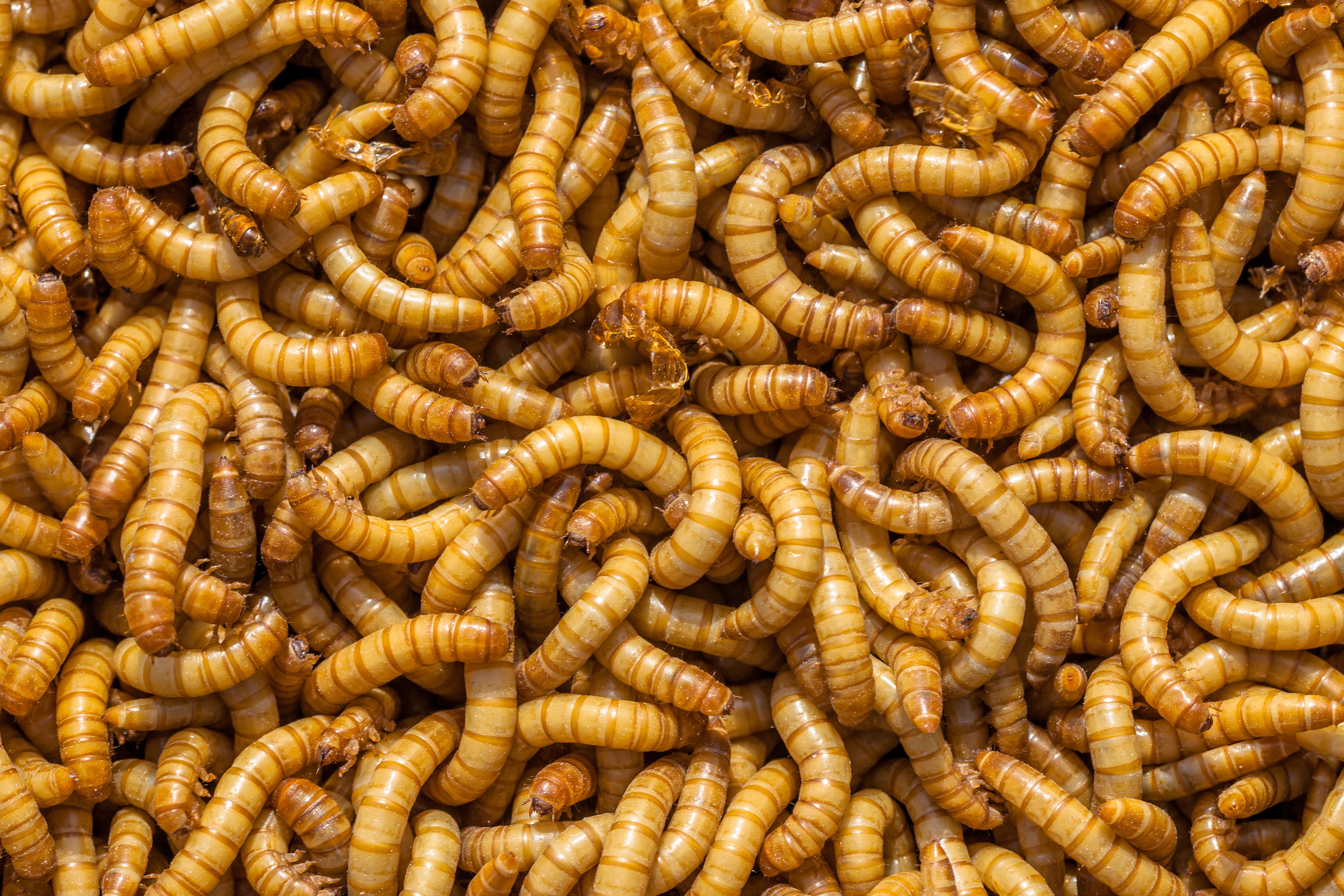It turns out that mealworms are so nutrient-packed they're being considered for human consumption. For starters, they're full of protein and are even used in many protein powders for weightlifters. But they also offer large amounts of fatty acids, minerals, vitamins, and fiber.
It's more likely that you want to raise mealworms, though, for your pets. Growing worms yourself makes it much more affordable to feed animals you might own.
If you're interested in learning how to raise mealworms, consider reading ahead.
What Are Mealworms
Mealworms are the larval form of the mealworm beetle, also known as the darling beetle. They have four life stages, starting as an egg, emerging as large, evolving to pupa, and shedding into an adult mealworm beetle.
Growing worms at home is an excellent option, as mealworms are quick to breed and easy to maintain. Females can lay about 500 eggs in their lifespan. Surprisingly, eggs can hatch within just 19 days!
In the past, mealworms were considered pests. They would quickly consume stored grains, as they were hard to spot and quick to feed. They seem to have originated from the Mediterranean region and spread thanks to global trade.
Over time, mealworms became a great food source for chickens and other birds and were excellent bait for fishing. This is due to their extremely high nutritional content. Every 100 grams of mealworm has 206 calories and up to 25 grams of protein!
What Do Mealworms Eat
Meal worms are very easy to feed, one of the main reasons they're so great for growing at home. They've even been known to eat plastics! You don't have to provide a very varied diet, but you need to provide enough food and water for the mealworms to thrive.
The proper way to feed mealworms is to use a substrate of oatmeal or wheat bran. That is, you must provide bedding where mealworms live, eat, and gestate. It's important to avoid fine-milled grains and whole grains, as they cannot survive in them.
Wheat bran and oatmeal are both excellent choices, but they provide different benefits. Wheat bran makes it easier for mealworms and beetles to move around but isn't consistent enough to be used as the bedding. Meaning you'll need to use other materials to create optimal bedding.
Oatmeal is more expensive, but it serves as fantastic bedding for mealworms. It's important to note that it can sometimes get dense and make it difficult for mealworms to move. Additionally, it's harder to differentiate mealworms from oatmeal due to color similarities, but it's still a great choice.
Raising Mealworms
Raising mealworms, or putting together a mealworm farm, requires a bit of time and organization at the start. Afterward, the process becomes straightforward. It's also worth mentioning that purchasing mealworms is quite expensive, so starting your own mealworm farm can save you a lot of money.
Mealworm Life Cycle
Understanding the mealworm life cycle is crucial before starting a mealworm farm. This is primarily because the beetle stage is where eggs are laid. Many that start their own farm forget this and end up surprised when new mealworms aren't being born. You have to let a certain amount of mealworms reach adulthood to prevent population stagnation.
Mealworm eggs are laid in the hundreds over the course of 1 to 5 months. Eggs hatch between 7 and 14 days, and the tiny mealworms mature in about 3 months.
Full-grown mealworms will enter the pupa stage and stay in that state for 2 to 4 weeks, depending on the environmental conditions. These hatch into yellowish beetle.
The yellowish beetle will turn black within a week. They'll quickly mate with the other beetles in the farm and lay eggs over the course of a few months.
What You'll Need
To get started with your mealworm farm, you'll need to buy mealworms. It's recommended to get between 500 and 1000 mealworms. Then, you'll want to find a good container, usually at least 12 inches high, 24 inches wide, and 12 inches deep. It's preferable to avoid a lid, and use a screen mesh to cover the container.
Make sure the container is clean, and place it in a room or area that's dark, humid, and as close to 80 degrees Fahrenheit as possible. Then, you'll need to add your substrate, preferably oatmeal or wheat bran. You can also use cereal or chicken mash, though.
At this point, you're ready to add your mealworms to the container. It's time to leave them alone and let them do their thing. Don't worry about overfeeding them, as they self-regulate their diet!
Growing Worms: How to Collect Them
After a few months, you'll be ready to collect your first batch of mealworms and start using them to feed your other pets. Keep in mind that it might not be safe to feed pupae or beetles to other animals. Additionally, these should be left in the mealworm farm to allow procreation.
When collecting your mealworms, check for and remove any moldy items in the habitat. You don't have to get rid of any dead beetles, though. The larvae will eat them.
When you're ready to collect your mealworms, the easiest way to do so is with food. You can place a vegetable in the corner of the habitat and leave it alone for 5 to 10 minutes. The mealworms will flock to it and attach themselves to it.
All that's left is to carefully pull the vegetable out of the mealworm farm and take it to an empty container. You can manually remove the mealworms by shaking the vegetable or softly brushing them off.
If you have an especially successful harvest, you can bag extra mealworms and put them in the freezer. Now all that's left to do is wait for the beetles to breed and start the process all over again!
Raise Mealworms Today
Raising mealworms might seem like a complicated endeavor. It's really all about patience, though. Once you have your container ready, add the food, and then add the mealworms, it gets really quite simple. All that's left is to wait and harvest the mealworms after some time.
Always remember to leave about 10% of the beetle and pupa population in the habitat. Otherwise, they won't be able to repopulate fast enough.
Get in touch if you're interested in buying mealworms wholesale, or just need a batch to get started. We're more than happy to supply you and answer any questions you might have before you start to raise mealworms at home!

